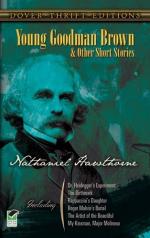|
This section contains 416 words (approx. 2 pages at 400 words per page) |

|
1692: The Salem Witch Trials result in the hanging deaths of nineteen people accused of being witches.
1835: Hawthorne, a descendant of one of the judges who presided over the Witch Trials, publishes "Young Goodman Brown." The allegorical tale explores the society and the mindset that spawned the trials.
1996: Arthur Miller's play, The Crucible, is adapted for film. In 1953 Miller's play used the Salem Witch Trials as an allegory to condemn the actions of Sen. Joseph McCarthy's House Un-American Activities Committee.
1690: The first newspaper in British North America, Publick Occurrences Both Foreign and Domestick, is established. The Governor of Massachusetts scuttles the paper before the end of the year.
1835: James Gordon Bennett opens the New York Herald. Six years later, the New York Tribune is founded. These papers, which cost one penny, are meant to reach the multitudes and be non-partisan.
1997: USA Today is the nation's...
|
This section contains 416 words (approx. 2 pages at 400 words per page) |

|




